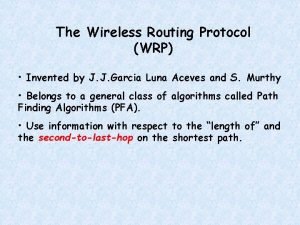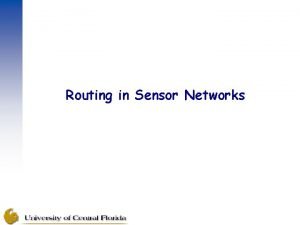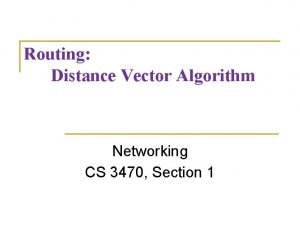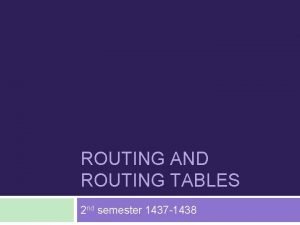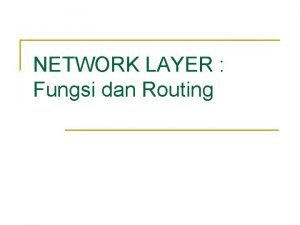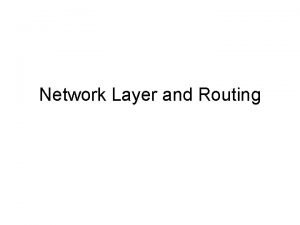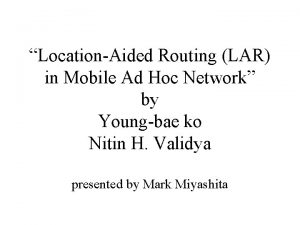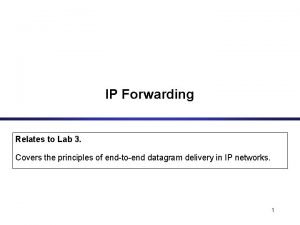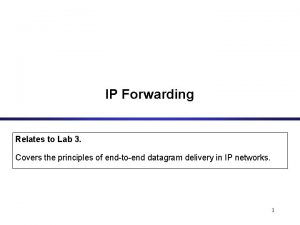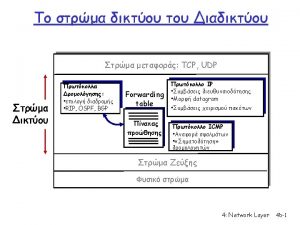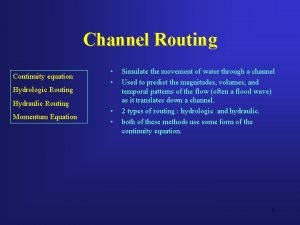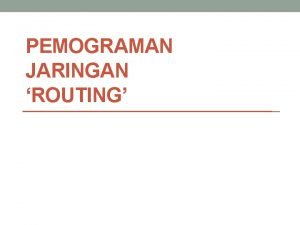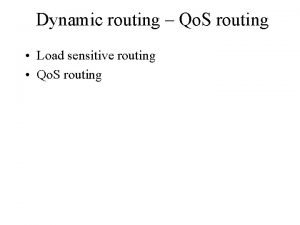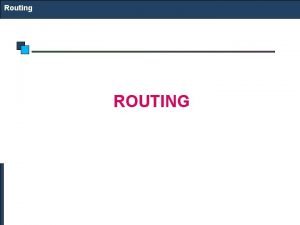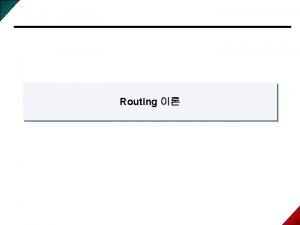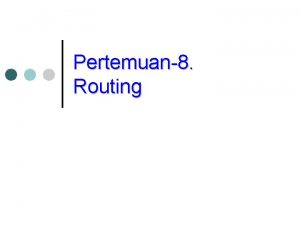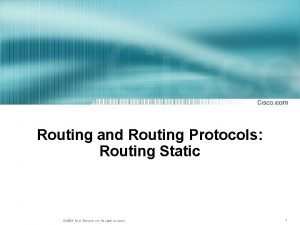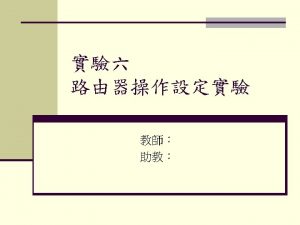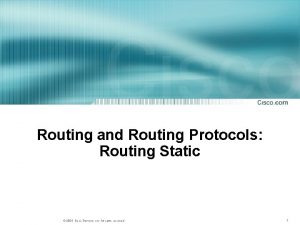An Introduction to Channel Routing 20080711 A Channel


































- Slides: 34

An Introduction to Channel Routing 曾奕倫 元智大學資訊 程系 2008/07/11

A Channel Routing Problem 2

A Channel Routing Problem (cont’d) 3

A Channel Routing Problem (cont’d) 4

A Solution to the Channel Routing Problem 5

A Solution to the Channel Routing Problem (in VLSI Physical Design) Ø Different colors represent different layers. 6

A Solution to the Channel Routing Problem (cont’d) Minimizing the number of tracks means minimizing the routing area. 7

A Channel Routing Problem 8

A Channel Routing Problem (cont’d) 9

Description of a Channel Routing Problem # Description of a Channel Routing # Problem Columns: 1 2 3 4 5 6 7 Nets: A B C D E F Top_Row: C NULL F E B NULL A Bottom_Row: A NULL B C Left_Nets: A D F Right_Nets: D E (The Input to Your Channel Router) 10

Vertical Constraint Graph Ø At column 1, the horizontal segment of net C must be placed above the horizontal segment of net A. 11

Vertical Constraint Graph (cont’d) Ø At column 1, the horizontal segment of net C must be placed above the horizontal segment of net A. 12

Vertical Constraint Graph (cont’d) Ø At column 4, the horizontal segment of net E must be placed above the horizontal segment of net B. 13

Vertical Constraint Graph (cont’d) Ø At column 7, the horizontal segment of net D must be placed above the horizontal segment of net C. VCG 14

The Left-Edge Algorithm • Proposed by Hashimoto and Stevens in 1971 • Regarded as the first channel routing algorithm • Can be used in solving Channel Routing Problems • Originally used in PCB design • Can be applied on VLSI physical design • Requires building the Vertical Constraint Graph (VCG) for a channel routing problem 15

The Left-Edge Algorithm (cont’d) Step 1: Build VCG 16

The Left-Edge Algorithm (cont’d) Step 2: Place horizontal segments Ø Consider horizontal segments of N 1, N 4, and N 10 (the nets that do not have ancestors) 17

The Left-Edge Algorithm (cont’d) Step 2: Place horizontal segments Ø N 1 has the smallest x coordinate Ø N 1 and N 4 cannot be placed on the same track Ø N 1 and N 10 can be placed on the same track Ø Place N 1 and N 10 on the highest track 18

The Left-Edge Algorithm (cont’d) Step 2: Place horizontal segments Ø N 1 has the smallest x coordinate Ø N 1 and N 4 cannot be placed on the same track Ø N 1 and N 10 can be placed on the same track Ø Place N 1 and N 10 on the highest track 19

The Left-Edge Algorithm (cont’d) Step 2: Place horizontal segments Ø Update the VCG (remove N 1 and N 10 from the VCG) 20

The Left-Edge Algorithm (cont’d) Step 2: Place horizontal segments Ø Update the VCG (remove N 1 and N 10 from the VCG) 21

The Left-Edge Algorithm (cont’d) Step 2: Place horizontal segments Ø Consider horizontal segments of N 4 and N 7 (the nets that do not have ancestors) 22

The Left-Edge Algorithm (cont’d) Step 2: Place horizontal segments Ø Consider horizontal segments of N 4 and N 7 (the nets that do not have ancestors) 23

The Left-Edge Algorithm (cont’d) Step 2: Place horizontal segments Ø Consider horizontal segments of N 4 and N 7 (the nets that do not have ancestors) Ø N 4 has the smallest x coordinate Ø N 4 and N 7 cannot be placed on the same track Ø Place N 4 on the second highest track 24

The Left-Edge Algorithm (cont’d) Step 2: Place horizontal segments Ø Consider horizontal segments of N 4 and N 7 (the nets that do not have ancestors) Ø N 4 has the smallest x coordinate Ø N 4 and N 7 cannot be placed on the same track Ø Place N 4 on the second highest track 25

The Left-Edge Algorithm (cont’d) Step 2: Place horizontal segments Ø Update the VCG (remove N 4 from the VCG) 26

The Left-Edge Algorithm (cont’d) Step 2: Place horizontal segments Ø Update the VCG (remove N 4 from the VCG) Ø Repeat the placement iterations … 27

The Left-Edge Algorithm (cont’d) - Result of the Example 28

The Left-Edge Algorithm (cont’d) - Result of the Example N 1 = 5 N 2 = 1 N 3 = 2 N 4 = 4 N 5 = 3 N 6 = 2 N 7 = 3 N 8 = 1 N 9 = 2 N 10 = 5 (The Output of Your Channel Router) 29

The Left-Edge Algorithm (summary) • Step 1: Build the Vertical Constraint Graph (VCG) for the input channel routing problem • Step 2: Place horizontal segments (choose nets (1) that do not have ancestors in the VCG and (2) whose horizontal segments do not overlap) and update the VCG • Step 3: Repeat Step 2 until all the horizontal segments have been placed 30

A Channel Routing Problem Dogleg Channel Routing 31

A Channel Routing Problem (cont’d) Loop VCG Ø The Left-Edge Algorithm cannot deal with a channel routing problem whose VCG contains loops. 32

Channel Density Ø Channel Density = 5 Ø At least 5 tracks are required in order to solve this channel routing problem (with or without doglegs). 33

To-Do List • Choose a Programming Language • Implement a Graphical User Interface (GUI) for displaying (1) a channel routing problem (the input) and (2) its solution (the output) • Implement the Left-Edge Algorithm – Build the VCG (step 1) • Data Structure (Adjacency List) • How to find nets that have no ancestors in the VCG • How to delete nets from the VCG – Placement of horizontal segments (step 2) • How to check the existence of loops in a VCG 34
 Muskingum method
Muskingum method Mark tinka
Mark tinka Hydrologic routing and hydraulic routing
Hydrologic routing and hydraulic routing Comparison of clock routing and power routing
Comparison of clock routing and power routing Greedy channel routing classified under the type of:
Greedy channel routing classified under the type of: Channel routing in vlsi
Channel routing in vlsi Introduction to dynamic routing protocols
Introduction to dynamic routing protocols Multi-channel retailing definition
Multi-channel retailing definition Signal space analysis in digital communication
Signal space analysis in digital communication Determine id
Determine id Ap layer in vlsi
Ap layer in vlsi Routing table
Routing table Contoh routing sheet
Contoh routing sheet Sd-wan segmentation
Sd-wan segmentation Rumor routing
Rumor routing Routing statyczny
Routing statyczny Routing overlays
Routing overlays Tabel routing static
Tabel routing static Tabel routing
Tabel routing Path vector routing
Path vector routing Rumour routing
Rumour routing Vector algorithm
Vector algorithm Routing area update
Routing area update Routing table
Routing table Precision routing
Precision routing Ortec routing and dispatch
Ortec routing and dispatch Fungsi routing di network layer
Fungsi routing di network layer Responsibility of network layer
Responsibility of network layer Intelligent customer routing
Intelligent customer routing Lar routing protocol
Lar routing protocol Dynamic routing packet tracer
Dynamic routing packet tracer Igmpv
Igmpv Routing table longest prefix match
Routing table longest prefix match Routing table longest prefix match
Routing table longest prefix match Interplay between routing and forwarding
Interplay between routing and forwarding











